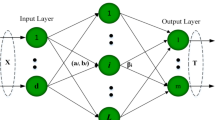Abstract
The incremental extreme learning machine (I-ELM) was proposed in 2006 as a method to improve the network architecture of extreme learning machines (ELMs). To improve on the I-ELM, bidirectional extreme learning machines (B-ELMs) were developed in 2012. The B-ELM uses the same method as the I-ELM but separates the odd and even learning steps. At the odd learning step, a hidden node is added like I-ELM. At the even learning step, a new hidden node is added via a formula based on the former added node result. However, some of the hidden nodes generated by the I-ELM may play a minor role; thus, the increase in network complexity due to the B-ELM may be unnecessary. To avoid this issue, this paper proposes an enhanced B-ELM method (referred to as EB-ELM). Several hidden nodes are randomly generated at each odd learning step, however, only the nodes with the largest residual error reduction will be added to the existing network. Simulation results show that the EB-ELM can obtain higher accuracy and achieve better performance than the B-ELM under the same network architecture. In addition, the EB-ELM can achieve a faster convergence rate than the B-ELM, which means that the EB-ELM has smaller network complexity and faster learning speed than the B-ELM.


Similar content being viewed by others
References
Schmidt WF, Kraaijveld MA, Duin RPW (1992) Feedforward neural networks with random weights. In: Proceedings of the 11th IAPR international conference on pattern recognition. doi:10.1109/ICPR.1992.201708
Pao YH, Takefuji Y (1992) Functional-link net computing: theory, system architecture, and functionalities. Computer 25(5):76–79
Igelnik B, Pao YH (1995) Stochastic choice of basis functions in adaptive function approximation and the functional-link net. IEEE Trans Neural Netw 6(6):1320–1329
Zhang L, Suganthan PN (2016) A comprehensive evaluation of random vector functional link networks. Inf Sci 367–368:1094–1105
Huang GB, Zhu QY, Siew CK (2004) Extreme learning machine a new learning scheme of feedforward neural networks. In: Proceedings of 2004 IEEE international joint conference on neural networks, vol 2. IEEE, pp 985–990
Huang G, Huang GB, Song SJ, You KY (2015) Trends in extreme learning machines: a review. Neural Netw 61:32–48
Huang ZY, Yu YL, Gu J, Liu HP (2016) An efficient method for traffic sign recognition based on extreme learning machine. IEEE Trans Cybern 47(4):920–933
Xie ZG, Xu K, Shan W, Liu LG, Xiong YS, Huang H (2015) Projective feature learning for 3D shapes with multi-view depth images. Comput Graph Forum 34(7):1–11
Zhao XG, Ma ZY, Zhang Z (2017) A novel recommendation system in location-based social networks using distributed ELM. Memet Comput. doi:10.1007/s12293-017-0227-4
Zhang N, Ding SF (2017) Unsupervised and semi-supervised extreme learning machine with wavelet kernel for high dimensional data. Memet Comput 9(2):129–139
Das SP, Padhy S (2016) Unsupervised extreme learning machine and support vector regression hybrid model for predicting energy commodity futures index. Memet Comput. doi:10.1007/s12293-016-0191-4
Xiao CX, Dong ZY, Xu Y, Meng K, Zhou X, Zhang X (2016) Rational and self-adaptive evolutionary extreme learning machine for electricity price forecast. Memet Comput 8(3):223–233
Tissera MD, McDonnell MD (2016) Deep extreme learning machines: supervised autoencoding architecture for classification. Neurocomputing 174(22):42–49
Liu HP, Li FX, Xu XY, Sun FC (2017) Active object recognition using hierarchical local-receptive-field-based extreme learning machine. Memet Comput. doi:10.1007/s12293-017-0229-2
Huang GB, Chen L, Siew CK (2006) Universal approximation using incremental constructive feedforward networks with random hidden nodes. IEEE Trans Neural Netw 17(4):879–892
LeCun Y, Boser B, Denker JS, Howard RE, Hubbard W, Jackel LD, Henderson D (1989) Handwritten digit recognition with a back-propagation network. In: Advances in Neural Information Processing Systems, Kaufmann, San Francisco, CA, USA, pp 396–404
Huang GB, Chen L (2008) Enhanced random search based incremental extreme learning machine. Neurocomputing 71(s 16–18):3460–3468
Yang YM, Wang YN, Yuan XF (2012) Bidirectional extreme learning machine for regression problem and its learning effectiveness. IEEE Trans Neural Netw Learn Syst 23(9):1498–1505
Rong HJ, Ong YS, Tan AH, Zhu Z (2008) A fast pruned-extreme learning machine for classification problem. Neurocomputing 72(1):359–366
Miche Y, Sorjamaa A, Bas P, Simula O, Jutten C, Lendasse A (2010) OPELM: optimally pruned extreme learning machine. IEEE Trans Neural Netw 21(1):158–162
Zhang R, Lan Y, Huang GB, Xu ZB (2012) Universal approximation of extreme learning machine with adaptive growth of hidden nodes. IEEE Trans Neural Netw Learn Syst 23(2):365–371
Feng GR, Huang GB, Lin QP, Gay R (2009) Error minimized extreme learning machine with growth of hidden nodes and incremental learning. IEEE Trans Neural Netw 20(8):1352–1357
Yang YM, Wu JQM (2016) Extreme learning machine with subnetwork hidden nodes for regression and classification. IEEE Trans Cybern 46(12):2570–2583
Lichman M (2013) UCI machine learning repository. http://archive.ics.uci.edu/ml. University of California, School of Information and Computer Science, Irvine
Tüfekci P (2014) Prediction of full load electrical power output of a base load operated combined cycle power plant using machine learning methods. Int J Electr Power Energy Syst 60:126–140
Yeh IC (1998) Modeling of strength of high performance concrete using artificial neural networks. Cem Concr Res 28(12):1797–1808
Tsanas A, Xifara A (2012) Accurate quantitative estimation of energy performance of residential buildings using statistical machine learning tools. Energy Build 49:560–567
Cortez P, Cerdeira A, Almeida F, Matos T, Reis J (2009) Modeling wine preferences by data mining from physicochemical properties. Decis Support Syst 47(4):547–553
Coraddu A, Oneto L, Ghio A, Savio S, Anguita D, Figari M (2014) Machine learning approaches for improving condition-based maintenance of naval propulsion plants. J Eng Marit Environ 230(8):136–153
Acknowledgements
The authors would like to thank the editor and reviewers for their invaluable suggestions to improve the quality of this paper. This research is supported by the National Natural Science Foundation of China under Grant No. 61672358.
Author information
Authors and Affiliations
Corresponding author
Electronic supplementary material
Below is the link to the electronic supplementary material.
Rights and permissions
About this article
Cite this article
Cao, W., Ming, Z., Wang, X. et al. Improved bidirectional extreme learning machine based on enhanced random search. Memetic Comp. 11, 19–26 (2019). https://doi.org/10.1007/s12293-017-0238-1
Received:
Accepted:
Published:
Issue Date:
DOI: https://doi.org/10.1007/s12293-017-0238-1




